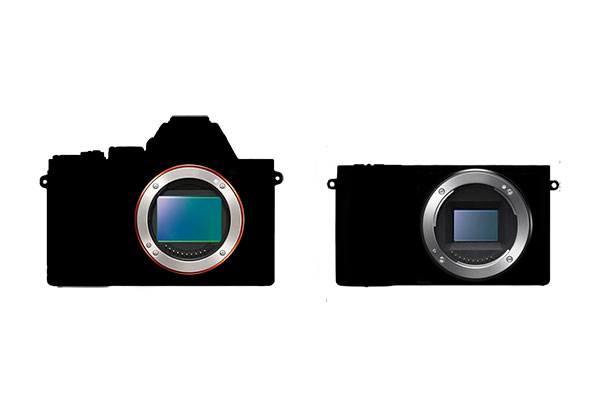First, a little bit of history…
Without going all the way back to the beginning, digital SLR cameras first arrived on the market in the late 1990’s when manufacturing a digital camera with the same size sensor as a 35mm film camera (or sensor size 36mm x 24mm, aka full-frame) was too expensive to achieve. So instead, the camera manufacturers came out with an alternative – a smaller or ‘cropped’ sensor, and as a result digital SLR’s were less expensive to make. That’s the reason why any sensor smaller than the original ‘full-frame’ of the predecessor film camera, is considered a ‘cropped sensor’.
It wasn’t until 2002 that Canon released the first full-frame sized sensor with the Canon EOS-1Ds (11 megapixel) released onto the market. Five years later in 2007, Nikon released their first full-frame digital SLR, the Nikon D3. During this time, digital SLR cameras were rather expensive to purchase (i.e. the Canon would cost in the vicinity of US$8000) and both these camera models cameras were marketed at the professional end of the market.
Common image sensor formats and sizes in today’s ‘cropped sensor’ cameras
APS-C – sensor size 23.6mm x 15.7mm – 1.5 times smaller than full-frame. This type is used by camera manufacturers such as Nikon, Sony, Fuji (Canon has it’s own APS-C sensor).
APS-C (Canon) – sensor size 22.2mm x 14.8mm – 1.6 times smaller than full-frame and is only used by Canon.
Four-Thirds – sensor size 17.3mm x 13mm – 2 times smaller than full-frame. This type is used by Olympus and Panasonic.
1” Type – sensor size 13.2mm x 8.8mm – 2.7 times smaller than full-frame. Currently used by Canon, Panasonic and Sony.
Smart phones and the majority of point-and-shoot cameras have sensors that are significantly smaller again. For example, the sensors of iPhones from models 5s through to 8 are only 4.8mm x 3.6mm, or 7.5 times smaller than a full frame sensor.
Full Frame Sensor
Full Frame format details
Full-frame – has a sensor size of 36mm x 24mm. Used by Canon, Nikon, Sony, Pentax, Lieca and doesn’t have any cropping factor. This sensor size needs full frame lenses to match. Canon call them EF or RF lenses and Nikon Call these FX or Z mount lenses.
There are now several manufacturers of digital cameras that have camera bodies with a full frame sensor inside them. Sony has been making mirrorless (non DSLR) versions of full frame cameras for some years and now Canon and Nikon are now making mirrorless cameras too along side their more traditional DSLR models. Other manufacturers of full frame cameras are Pentax and Leica.
Advantages of a full frame sensor
• Better overall image quality compared to a cropped sensor
• Capable of producing shallower depth of field compared to a cropped sensor with the same lens and subject distance
• Wide angle lenses give a wider field of view compared to cropped sensor camera body with the same lens
• Low light performance is enhanced due to the 2.4 x larger sized sensor area compared to APS-C sensor
• Lower noise at high ISO
• Advanced features also put into these camera bodies (suitable for professional work)
Disadvantages of a full frame sensor
• Higher cost of the camera body
• Generally found with a larger and heavier camera body
• Mostly higher cost and heavier lenses compared to cropped lenses
• Telephoto lenses don’t have the same “reach” compared to a cropped sensor camera body. This “reach” refers to the wider field of view that a full frame camera has with a given lens – see Cropped Sensor for more information
• Can’t use all the same lenses that a cropped sensor camera body – for example: Canon EF-S lenses cannot be used on full frame Canon camera bodies
• Modern hi-resolution full frame cameras will show any weaknesses of many older or low quality full frame lenses
Cropped Sensor
A cropped sensor is smaller than a 35mm frame which means the circle of light coming from a lens required to illuminate this sensor can also be smaller. This translates into smaller, lighter and cheaper lenses designed specifically for these cameras. Nikon calls these DX lenses and Canon EF-S lenses.
When talking about cropped sensor digital cameras there is also a term called ‘cropping factor’. This ‘cropping factor’ or ‘lens multiplier’ is used because a cropped sensor camera is 1.5 (Nikon) or 1.6 (Canon) times smaller diagonally than a 35mm full frame camera. So to get an equivalent field of view compared to a 35mm full frame camera you need to multiply your lenses by 1.5 or 1.6 (depending on manufacturer). See the visual example at the bottom of this article for the effect of this cropping factor.
Advantages of a cropped sensor
• Lower cost compared to full frame cameras
• Smaller and lighter camera bodies compared to full frame cameras
• Telephoto lenses have more “reach” because of their narrower field of view compared to a full frame camera – 1.5 or 1.6 times narrower field of view
• Lenses designed for cropped sensor camera bodies are cheaper, lighter and more compact than their full frame counterparts
• Lenses designed for full frame camera bodies can also be used on cropped sensor camera bodies
• When using full frame lenses it uses the “sweet spot” or best performing part of the lens optics (the centre region)
Disadvantages of a cropped sensor
• For a wide field of view you need a much wider lens than on a full frame camera
• A cropped sensor with the same or similar pixel count will not perform as well in low light as a full frame sensor due to lower total sensor surface area compared to full frame
• If you want a shallow depth of field then the greater depth of field provided by a cropped sensor camera may be an issue (e.g. portrait photographers)
Field of View and Focal Length
The field of view is the most visible difference between full-frame and cropped sensor cameras. Compare these two images for instance. When you take the same photo from the same distance and effectively the same focal length setting, a shot taken with a full-frame camera will have a wider field of view than the image taken with a cropped sensor camera. The latter produces a narrower field of view (giving a zoomed-in affect).

With the same scene and lens focal length, a full frame camera can capture a wider field of view and cropped sensor camera will capture much less of the same scene. Here is an example of a shot taken with a 14mm lens on my Canon 5Ds full frame camera.

Here is an example of the same shot if it were taken with the same 14mm lens mounted on a Canon 1.6 x cropped camera body. Note the narrower field of view is now equivalent to a 22.4mm full frame lens (14mm x 1.6 cropping factor = 22.4mm). If you wanted a similar field of view on the cropped camera you would need to buy a 8.75mm lens and I am only aware of a lens made by Sigma which goes down to 8mm (currently Canon native EF-S lenses start at 10mm for their widest).
So what should I choose? A camera with a full-frame sensor or cropped sensor?
The answer to this question primarily comes down to your budget, how you intend to use your camera and the purpose of the resulting images. If you have a budget that allows and you’re after the ultimate image quality, then it’s definitely worth considering a full frame camera body with quality lenses to match. Cropped sensor cameras are certainly more affordable and will still allow you to create great images – these are generally in the ‘consumer’ or ‘enthusiast’ range of cameras and are manufactured for the majority of amateur photographers.
Keep in mind though, if you are starting with a cropped sensor camera but have a plan to upgrade to a full frame camera in the future, carefully consider your choice of lenses. Lenses that are functional on cropped sensor camera bodies may not work on a full frame camera body; but full frame lenses generally work on both. Making yourself aware of the compatibility of lenses to your choice of camera body will help you make an informed choice from the beginning.
It’s also worth remembering that purchasing a top of the range camera won’t necessarily mean that you will be become an award-winning photographer straight away, or immediately start shooting like a pro! Photography is a life-long learning curve – it can take years to develop your knowledge, technique and style, not to mention lots of practice, to become an accomplished photographer.






